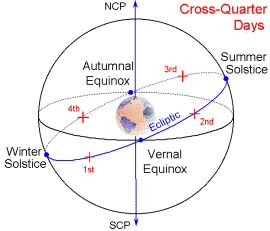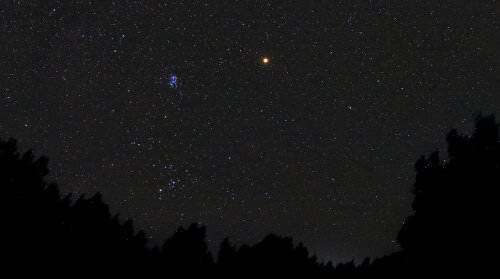Spooky Astronomy: Halloween is a big night for astronomers

According to the National Retail Foundation, the most popular Halloween costume last year was Spiderman. Next was "a princess," followed by witches and vampires, SpongeBob, Barbie and Harry Potter.
Sounds about right. But if you read the complete list of top costumes, you'll notice something missing: astronomers. There are no Sagans, no Galileos, not even a Hubble.
And that's funny, because Halloween is an astronomical holiday.
Image: Red crosses mark the year's cross-quarter dates.
It has to do with seasons: Halloween is a "cross-quarter date," approximately midway between an equinox and a solstice. There are four cross-quarter dates throughout the year, and each is a minor holiday: Groundhog Day (Feb. 2nd), May Day (May 1st), Lammas Day (Aug. 1st), and Halloween (Oct. 31st).
Long ago, "the Celts of the British Isles used cross-quarter days to mark the beginnings of seasons," says John Mosley of the Griffith Observatory in Los Angeles. "Winter began with Halloween, [or as they called it, 'Samhain']. Halloween marked the transition between summer and winter, light and dark -- and life and death."
"On that one night, according to folklore, those who had died during the previous year returned for a final visit to their former homes. People set out food and lit fires to aid them on their journey -- but remained on guard for mischief the spirits might do."
And, so, something astronomical became something spooky. It's not the first time. Have you heard that comets are bad omens? Or that a full moon brings out werewolves? Astronomy and superstition are old friends.
This year Halloween has a new astronomical significance:
On Oct. 31st, the planet Mars is making its closest approach to Earth for the next 13 years. (13 years? Cross your fingers.) Technically speaking, the moment of closest approach occurs on Oct. 30th, a day before Halloween, but the difference in distance between the 30th and the 31st is too slight to matter.

Image above: Mars rising over Payson Arizona on Oct. 25, 2005. Credit: Chris Shur.
Trick or Treaters will notice Mars rising in the east at sunset: sky map. It looks like a pumpkin-colored star, so intense that people in brightly-lit cities can see it. Some say it's blood red, but maybe that's just Halloween talking.
Mars will soar almost overhead at midnight (as seen from North America) and stay "up" all night long. Halloween 2005 is truly the night of Mars.
Because Mars is so close--only 69 million km away, which is close on the vast scale of the solar system--it looks great through a backyard telescope. Lately amateur astronomers have been watching dust storms swirl around Mars. They've seen icy-blue clouds gather over the Martian north pole, where it is winter. And they been sketching and photographing strange dark markings that dapple the planet's surface.
So--nothing against Spiderman, mind you--you might wish to reconsider your costume. Grab a telescope and be an astronomer. It is Halloween, after all.
Source: Science@NASA (by Dr. Tony Phillips)















